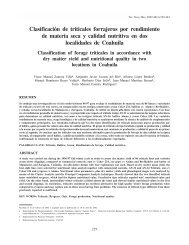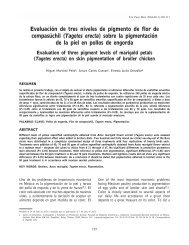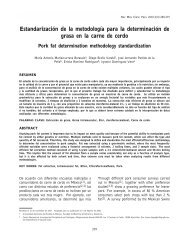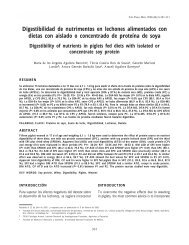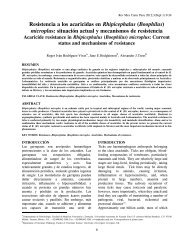Control de Rhipicephalus microplus - Revista Técnica Pecuaria en ...
Control de Rhipicephalus microplus - Revista Técnica Pecuaria en ...
Control de Rhipicephalus microplus - Revista Técnica Pecuaria en ...
You also want an ePaper? Increase the reach of your titles
YUMPU automatically turns print PDFs into web optimized ePapers that Google loves.
Melina Maribel Ojeda-Chi, et al. / Rev Mex Ci<strong>en</strong>c Pecu 2011;2(2):177-192<br />
Ma6 y Ma10 <strong>de</strong> M. anisopliae son efectivas <strong>de</strong> 60<br />
hasta 100 % <strong>de</strong> 6 a 13 días pos infección. En estudios<br />
in vitro realizados <strong>en</strong> la pulga Ct<strong>en</strong>ocephali<strong>de</strong>s felis<br />
felis, M. anisopliae (cepa E9) reduce la eclosión<br />
<strong>de</strong>l huevo y causa alta mortalidad a las 60 h a la<br />
conc<strong>en</strong>tración <strong>de</strong> 1x10 7, mi<strong>en</strong>tras que la cepa Ma595<br />
pres<strong>en</strong>ta 100 % <strong>de</strong> mortalidad a las 72 h (66).<br />
Mohanty et al (67), <strong>en</strong> estudios in vitro para evaluar<br />
la patog<strong>en</strong>icidad <strong>de</strong> la cepa 892 <strong>de</strong> M. anisopliae<br />
<strong>en</strong> la fase larvaria <strong>de</strong> los mosquitos Anopheles<br />
stephes y Culex quinquefasciatus, reportan una alta<br />
eficacia <strong>de</strong>l hongo para ambas especies. También<br />
se ha evaluado (68) la eficacia <strong>de</strong> M. anisopliae para<br />
el control <strong>de</strong> Varroa <strong>de</strong>structor y se reportan picos<br />
<strong>de</strong> mortalidad <strong>en</strong> 3 a 4 días pos tratami<strong>en</strong>to (PT).<br />
e) Factores que influy<strong>en</strong> <strong>en</strong> la patog<strong>en</strong>icidad<br />
A nivel <strong>de</strong> campo las condiciones climáticas, orig<strong>en</strong><br />
<strong>de</strong> la cepa y virul<strong>en</strong>cia influy<strong>en</strong> <strong>en</strong> la germinación<br />
<strong>de</strong> éstas (6,30). Los factores que afectan la eficacia<br />
<strong>de</strong> M. anisopliae se divi<strong>de</strong>n <strong>en</strong> dos grupos:<br />
Factores que afectan la sobreviv<strong>en</strong>cia. Los<br />
principales factores ambi<strong>en</strong>tales que interfier<strong>en</strong> con<br />
el crecimi<strong>en</strong>to, producción <strong>de</strong>l hongo y producción<br />
<strong>de</strong> micotoxinas son la actividad <strong>de</strong>l agua,<br />
temperatura, humedad, pH, textura <strong>de</strong>l suelo o<br />
composición <strong>de</strong> los sustratos y rayos ultravioleta<br />
(UV) (6,69,70). Se han realizado estudios que<br />
<strong>de</strong>muestran que los conidios con tolerancia a altas<br />
temperaturas y rayos UV produc<strong>en</strong> altas cantida<strong>de</strong>s<br />
<strong>de</strong> grasas saturadas y altas cantida<strong>de</strong>s <strong>de</strong> trealosa y<br />
manitol, las cuales prove<strong>en</strong> protección contra la<br />
<strong>de</strong>snaturalización <strong>de</strong> las proteínas y la<br />
membrana (70,71). Otros factores que se <strong>de</strong>b<strong>en</strong> <strong>de</strong><br />
tomar <strong>en</strong> cu<strong>en</strong>ta son las interacciones <strong>en</strong>tre el hongo<br />
y el medio ambi<strong>en</strong>te e interacciones con otros<br />
organismos, por ejemplo la utilización <strong>de</strong> sustratos<br />
<strong>de</strong>l medio y la producción <strong>de</strong> metabolitos<br />
(adaptación a niveles bajos <strong>de</strong> CO 2 y NaCl) (6).<br />
Factores que afectan el estado fisiológico <strong>de</strong> los<br />
conidios. La edad es uno <strong>de</strong> los factores que afectan<br />
a los conidios, ya que mi<strong>en</strong>tras más jóv<strong>en</strong>es sean<br />
existe una mayor germinación <strong>en</strong> comparación con<br />
los conidios antiguos. El agua favorece la<br />
germinación inicial <strong>de</strong> los conidios (72). La<br />
rehidratación <strong>de</strong> los conidios es vital <strong>en</strong> las primeras<br />
188<br />
rate, in contrast with ol<strong>de</strong>r conidia. Water promotes<br />
conidium initial germination (72). Conidial<br />
rehydration is vital in the first 48 h since, un<strong>de</strong>r<br />
stress conditions, only small amounts of mannitol<br />
are produced thus conidia can no longer tolerate<br />
high temperatures (6).<br />
f) Formulations<br />
Conidium application un<strong>de</strong>r field conditions is<br />
limited by the <strong>en</strong>vironm<strong>en</strong>t that can promote<br />
moisture loss, thus limiting conidial growth and<br />
their effects. Leemon et al (70) studied the effect of<br />
plant oil on M. anisopliae conidial germination<br />
and p<strong>en</strong>etration, and observed 100 % mortality of<br />
R. <strong>microplus</strong> by 2 to 5 d p.i. These results show<br />
that oil works as glue betwe<strong>en</strong> conidia and arthropod<br />
cuticle, and increases conidial livability probably<br />
by prev<strong>en</strong>ting water evaporation.<br />
Studies to evaluate the survival of conidia exposed<br />
to UV light in differ<strong>en</strong>t media (olive oil + solar<br />
filter; water + solar filter; and control) found 29<br />
to 40 %, 14 to 24 %, and 4 % conidial survival<br />
rates, respectively. These results suggest that both<br />
olive oil and solar filters protect conidia against<br />
UV radiation, not interfering with germination or<br />
pathog<strong>en</strong>icity. In addition, mixtures including the<br />
solar filter resulted in 88 to 94 % larval mortality<br />
and 81 to 83 % adult tick mortality.<br />
INTEGRATED PEST MANAGEMENT<br />
Integrated pest managem<strong>en</strong>t (IPM) consists of the<br />
proper combination of various control tools aiming<br />
to <strong>de</strong>stabilize the constitution of populations with<br />
higher proportions of g<strong>en</strong>etically-resistant<br />
individuals, while maintaining a<strong>de</strong>quate levels of<br />
production. IPM is typically associated with a drastic<br />
<strong>de</strong>crease in treatm<strong>en</strong>t frequ<strong>en</strong>cy. As stated above,<br />
resistance prev<strong>en</strong>tion/managem<strong>en</strong>t requires not only<br />
<strong>de</strong>creased <strong>de</strong>p<strong>en</strong><strong>de</strong>nce of antiparasitics, but also<br />
using such products on seasons/times/animals in<br />
such a way that it does not result in increased<br />
g<strong>en</strong>etic selection pressure (26).<br />
In or<strong>de</strong>r to achieve an effective managem<strong>en</strong>t of tick<br />
populations, minimizing tick effects, and preserving<br />
the available acarici<strong>de</strong>s, an IPM must be used.



